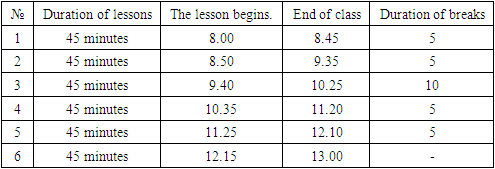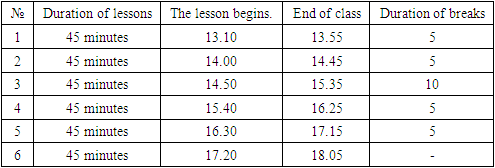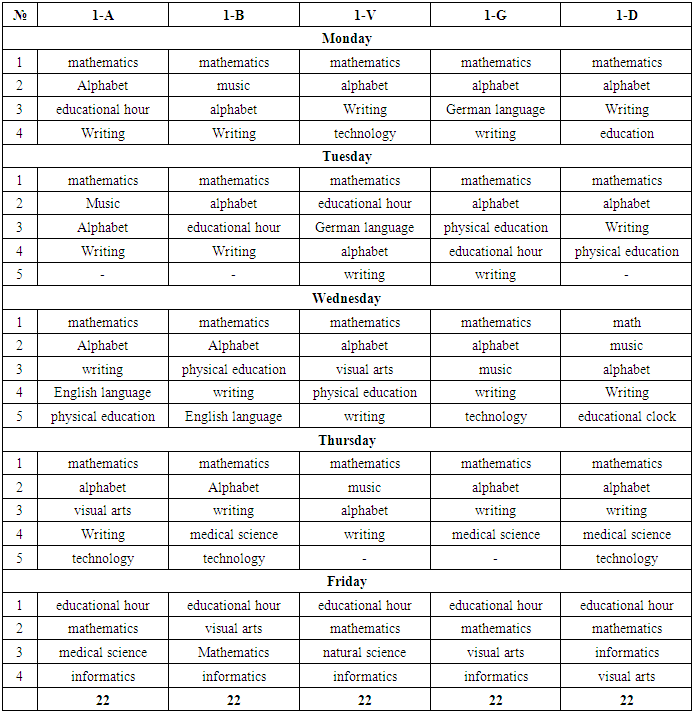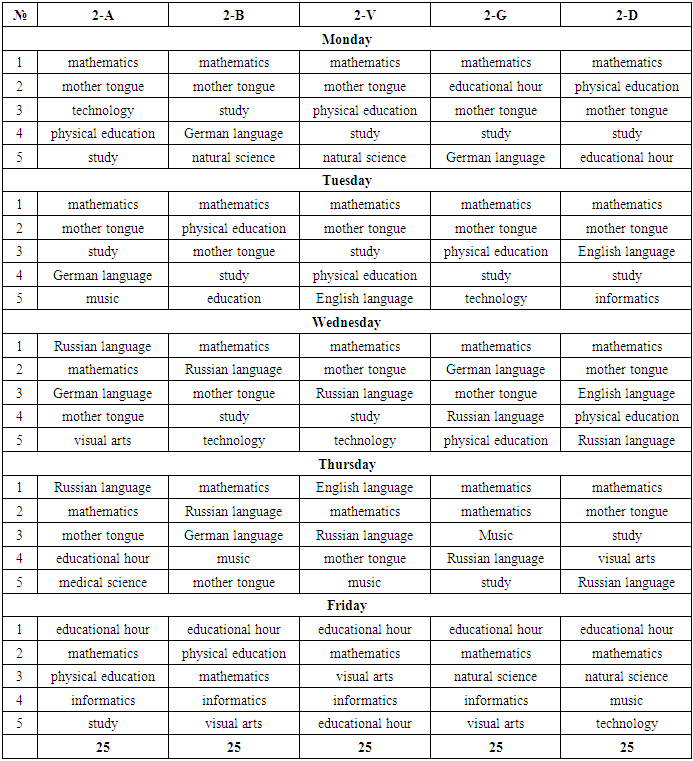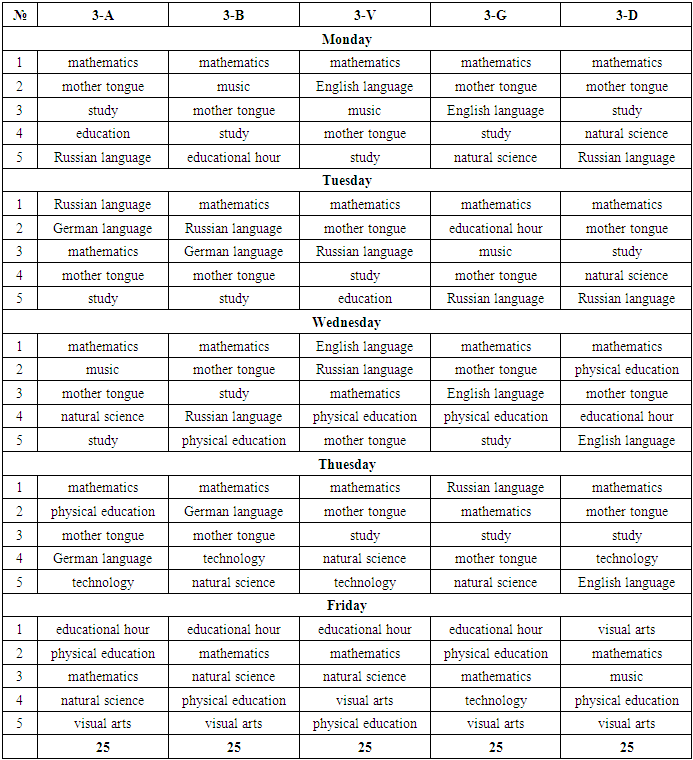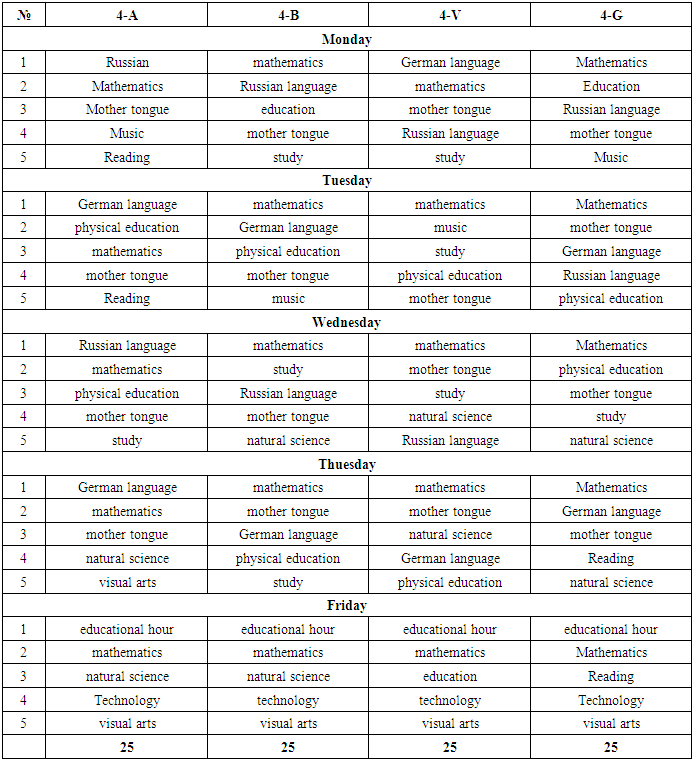-
Paper Information
- Next Paper
- Previous Paper
- Paper Submission
-
Journal Information
- About This Journal
- Editorial Board
- Current Issue
- Archive
- Author Guidelines
- Contact Us
American Journal of Medicine and Medical Sciences
p-ISSN: 2165-901X e-ISSN: 2165-9036
2025; 15(4): 972-981
doi:10.5923/j.ajmms.20251504.27
Received: Mar. 19, 2025; Accepted: Apr. 6, 2025; Published: Apr. 8, 2025

Hygienic Analysis of Educational Process in Primary Classes
Ermatov Nizom1, Akhunova Makhfuza2, Ashurova Mukaddas3, Berdiyev Olim4
1Professor, Head of the Department of Hygiene of Children, Adolescents and Nutrition, Tashkent Medical Academy, Tashkent, Uzbekistan
2PhD Student, Fergana Medical Institute of Public Health, Fergana, Uzbekistan
3PhD, Associate Professor, Head of the Department of Hygiene of Children, Adolescents and Nutrition, Fergana Medical Institute of Public Health, Fergana, Uzbekistan
4Assistant, Department of Hygiene of Children, Adolescents and Nutrition, Tashkent Medical Academy, Tashkent, Uzbekistan
Correspondence to: Ermatov Nizom, Professor, Head of the Department of Hygiene of Children, Adolescents and Nutrition, Tashkent Medical Academy, Tashkent, Uzbekistan.
| Email: |  |
Copyright © 2025 The Author(s). Published by Scientific & Academic Publishing.
This work is licensed under the Creative Commons Attribution International License (CC BY).
http://creativecommons.org/licenses/by/4.0/

The study analyzed the organization of the educational process of students in grades 1-4 of school No. 51 in the Tashlak district of the Fergana region for compliance with the requirements of the State Standard No. 0341–16 “Sanitary and epidemiological requirements for the conditions and organization of education in general education schools”. Educational activity at the school was assessed based on timekeeping. The number of primary classes in the school under observation is 10, and they study in the first shift on a 5-day schedule. Schoolchildren spend 4 hours a day at school in grades 1-2 and 5-6 hours in grades 3-4. The analysis of the lesson schedule of the elementary school students in the school shows that the weekly load of class 1-A is 22 hours, physical education for the first hour on Monday, mathematics lesson for the first hour on Tuesday, Wednesday and Thursday, and complex lessons for 1-2-3 hours on Tuesday, which do not meet hygienic requirements. In 4-A class, the first hour of mathematics on Mondays, Tuesdays, Wednesdays and Thursdays and the 5th hour of physical education on Mondays also do not meet hygienic requirements. The learning activity of 1st grade students studying on an incorrectly structured lesson schedule in mathematics on Wednesday, when their working capacity was high, was 56.6%, and their motor restlessness was 43.4%. The learning activity of 2nd grade students in computer science was 53.3%, and their motor restlessness was 46.7%, and their learning activity decreased by 3.3% compared to 1st grade. The level of complexity of the lessons was the most difficult day of the week, Monday, in 1st-V-grade 24 points, in grades G and D 29 points, in grades 2-B-G 30-33 points, in grades 3-A and B 33-32 points, in grades 4-A and V 32-34 points, and on Friday, the highest score was 26 points in grade 2-B.
Keywords: School students, Agenda, Educational process, Lesson schedule, Educational activity
Cite this paper: Ermatov Nizom, Akhunova Makhfuza, Ashurova Mukaddas, Berdiyev Olim, Hygienic Analysis of Educational Process in Primary Classes, American Journal of Medicine and Medical Sciences, Vol. 15 No. 4, 2025, pp. 972-981. doi: 10.5923/j.ajmms.20251504.27.
Article Outline
1. Introduction
- In the current period of development, the health status of schoolchildren and the effectiveness of their working capacity depend on the educational conditions in the school, the daily schedule, the organized learning process of students at school, their health status, living conditions and positive and negative environmental factors and their impact. The changes in school factors not only lead to a deterioration in the ability to work and the daily schedule of students, but also create conditions for the development of diseases associated with the educational process, as has been shown by the work of a number of authors [1,2,3,4,9,11]. The data presented by A.V. Suvarova et al. (2017) show that schools have developed their own foundations for organizing the educational process and preventive measures to reduce the negative impact of the daily schedule on the health of schoolchildren based on the methodology for assessing the risks affecting the health of schoolchildren. In this study, 360 secondary school students aged 15-17 (168 boys, 192 girls) from 5 schools with an advanced education system in St. Petersburg were monitored and integrated criteria were calculated for 44 parameters of the school environment. The health of secondary school students was assessed using the factors of the daily routine, educational process, relative risk indicators (RR), odds ratio (OR), etiological factor (EF) [5,6].Changes in the daily routine of school students and the changes that arise as a result of them were reflected in the results of an in-depth medical examination, which in turn showed a number of changes in the health of students. The daily routine of most schoolchildren does not meet the requirements, they have insufficient night sleep, little time for outdoor walks, the predominance of passive types of recreation, excessive use of mobile communication devices, irregular eating and high academic loads, and excessive additional classes. We can see that as a result of the shortcomings in the daily life of schoolchildren and the educational process, a number of changes in the health status of students have been identified [8,9,11]. Taking into account the above, hygienic analysis of the organization of the educational process among primary schoolchildren and improving the health status of students and preventing fatigue and exhaustion are one of the urgent problems facing professionals in the field.
2. Purpose of the Research
- The purpose of the research is to analyze the organization of the educational process and the structure of the lesson schedule of elementary school students in urban conditions.
3. Materials and Methods
- The research was conducted at School No. 10 in Fergana, Fergana region. The organization of the educational process in primary grades studying at the school was analyzed hygienically.The total number of students studying at the school was 1635, of which 580 (35.47%) were students in grades 1-4. The average number of students in a classroom was 28-33 (the norm is 25).The school consists of main classrooms, offices, chemistry, biology, physics, astronomy laboratories, technology workshops adapted to the laboratory, music rooms, a gym and a complex kitchen.The design and construction of schools was carried out based on the current regulatory documents (ShNK 2.07.01-03 “Urban planning. Planning of development and construction of urban and rural settlements”, ShNK 2.08.02-09 “Public buildings and structures”) [10] and the normative indicators of SanMvaK 0341-2016 “Sanitary and epidemiological requirements for the conditions and organization of education in general education schools” [7].The activity of students during the lesson was analyzed based on timing (N.Zh. Ermatov, F.L. Azizova, 2022).The statistical processing of the research results was carried out using the “Statistika for Windows 7.0” personal computer application package.
4. Results and Discussion
- The educational process at school forms the basis of the students' daily routine. A high-quality educational process depends primarily on the hygienic requirements of classrooms, microclimate parameters, school equipment and the number of students in classes. In this study, we considered it appropriate to focus on a hygienic analysis of the educational process of primary school students, the school day, the schedule of classes, the complexity of classes and their location.The monitored school No. 10 in Fergana city, Fergana region, has 19 primary classes, 1-2-3 classes consist of 5 classes A, B, V, G and D, and 4 classes consist of 4 classes A, B, V and G. What is most interesting is that the average number of students in the classes does not meet the generally established hygienic requirements, which is the first factor in the deterioration of the quality of the educational process and, along with fatigue, exhaustion, nervous and mental stress, creates conditions for deterioration of health and the development of somatic diseases. Hygienic analyzes have shown that the number of primary school students in the school we monitored exceeds the established requirements by 3-8 people in all classes, for example, in 1st grade by an average of 3 people, in 2-3rd grade by 6 people, and in 4th grade by 8 people. This situation, together with the microclimate indicators in the classroom, leads to a violation of the organization of the daily routine and the educational process and has a negative impact on the mastery of lessons. If the number of students in the classrooms is allowed to be more than 1-2 people, but the excess of 6-8 people and the fact that the classrooms were built based on the sanitary norms and rules in the regulatory documents at the time of their construction, and their size is less than the norm established in the regulatory document in force, has been shown.A disorderly and unhygienic schedule and daily routine that does not meet the requirements of the lesson have been shown in a number of studies [1,2,11].It was found that primary school students study in the first half of the day in the first shift at school and, in addition, spend at least 2 hours in groups allocated for additional classes in some subjects.In the conditions of New Uzbekistan, since 2017, in the 10th school in Fergana city, Fergana region, the educational process in primary grades will be carried out in a 5-day week, like in other cities and regions, which has led to an increase in daily lesson hours by 1 hour.It should be noted that since the study time in primary grades in the conditions of New Uzbekistan is set at 5 days a week, 4-5 academic hours of the main time of schoolchildren during the day are spent at school, which is an average of 4.4 hours.In addition, their travel time, breaks and time allocated for additional classes outside of school make up 4.0 hours. In general, schoolchildren aged 7-11 spend 8.4 and 9.0 hours at school. This makes up 75% of the time during the day. The time allocated by schoolchildren for other activities during the day does not meet hygienic requirements. For schoolchildren, additional lessons on Saturdays cause them to become tired, and their ability to work on Saturdays decreases due to physiological stress.One of the most important tasks should be to allocate 1.5-2 hours of the most important time in the daily schedule for daytime sleep, as well as time for daytime walks.Saturday and Sunday are the days off for schoolchildren.The daily schedule and distribution of lessons for schoolchildren in the first shift are presented in Table 1.
|
|
|
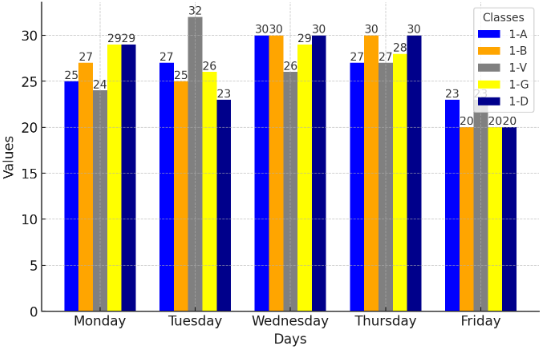 | Figure 1. The results of the level of complexity of the weekly downloads of the 1st graders |
|
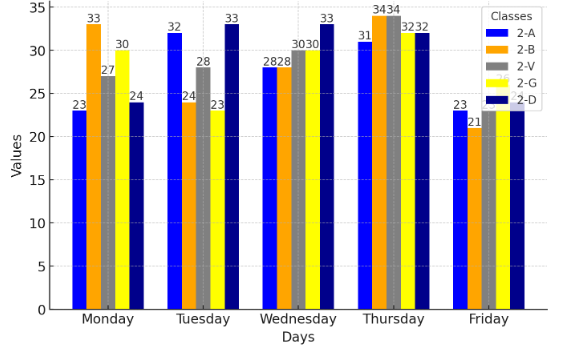 | Figure 2. Level of complexity of weekly assignments of 2nd graders |
|
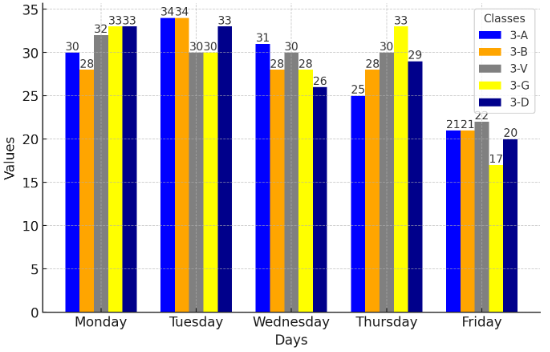 | Figure 3. The level of complexity of the weekly downloads of 3rd graders |
|
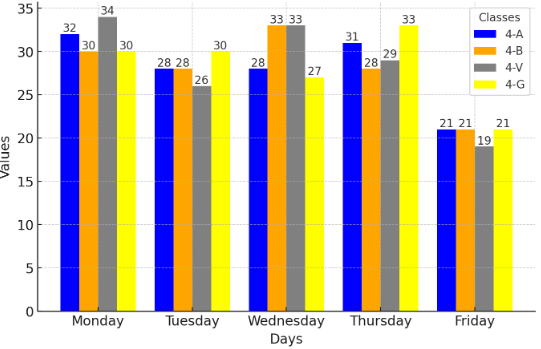 | Figure 4. The level of complexity of the weekly downloads of 4th graders |
5. Conclusions
- 1. The time spent by primary school students at school is 8.4 and 9.0 hours, the distribution of time during the day is 75%, and the time allocated to other activities during the day does not meet hygienic requirements. They do not have time for daytime sleep.2. The structure of the lesson schedule for primary school students does not meet hygienic requirements, the placement of mathematics in the first hour on four days of the week, that is, on Monday, Tuesday, Wednesday and Thursday, along with the placement of complex lessons or mathematics and languages in some classes, has shown that it is out of line with the requirements set out in regulatory documents.3. Despite the fact that the first hour of the second day of the week, Tuesday, is incorrectly divided into mathematics and foreign language lessons, in some classes of grades 2, complex lessons are assigned to the 1st, 2nd, and 3rd hours, while physical education lessons are assigned to the 1st classes for 4 hours, and computer science lessons are assigned to the 2nd classes for 4 hours, which also does not meet the requirements. The fact that serious errors were made in the distribution of lessons on Wednesday, Thursday, and Friday also created conditions for the distribution of students' time budget during the day and changes in it.4. The learning activity of the 1st grade students studying on the basis of an incorrectly structured lesson schedule was 56.6% in the math class on Wednesday, and the anxiety level was 43.4%. with respect to class chi decreased by 3.3%. In the individual analysis, the learning activity of a boy named M, who actively mastered science and was rated excellent by the teacher, was 57.5%, and that of a girl named G was 52.4%, and this is a low indicator.5. The level of difficulty of the lessons was the most difficult day of the week, Monday, with 24 points in 1st-V-grade, 29 points in G and D grades, 30-33 points in 2nd-B-G grades, 23-24 points in A and D grades, 33-32 points in 3rd-A and B grades, 28 points in G grade, 32-34 points in 4th-A and V grades, and 30 points in B and G grades. On Tuesday, 32 points in 1st-V-grade, 33 points in 2nd-A grade, 32 points in 2nd-D grade, and 30 points in 3rd-grade, with successively more difficult lessons and 30-33-34 points. On Friday, the highest score was 26 points in 2nd-B grade.
 Abstract
Abstract Reference
Reference Full-Text PDF
Full-Text PDF Full-text HTML
Full-text HTML